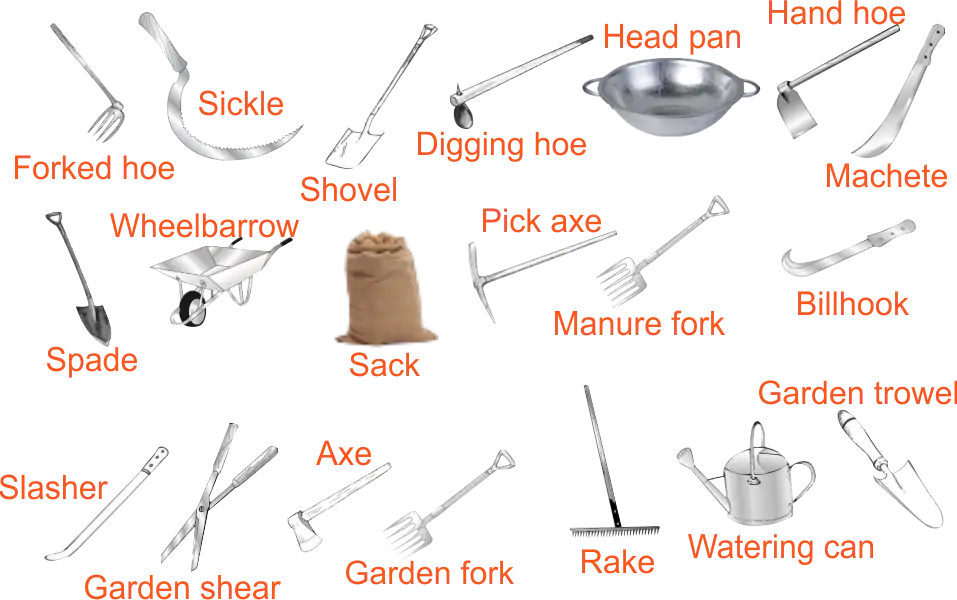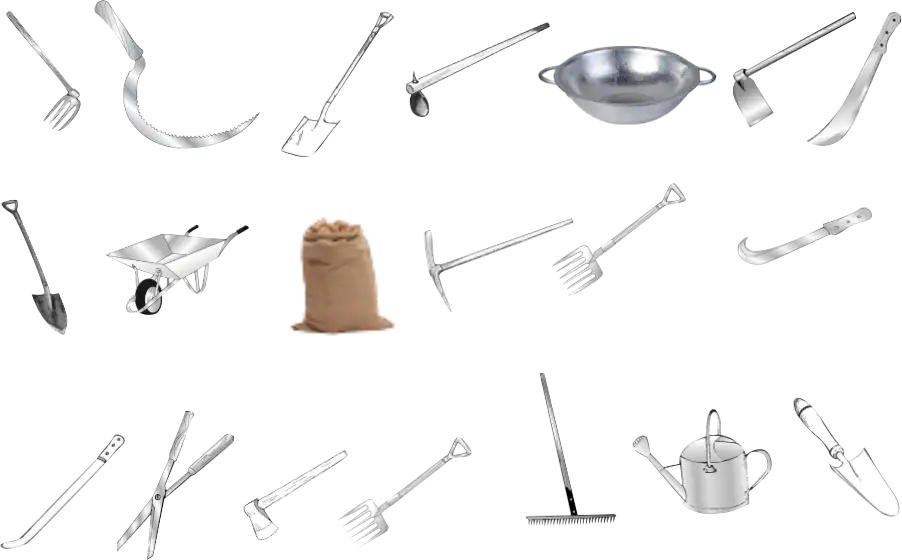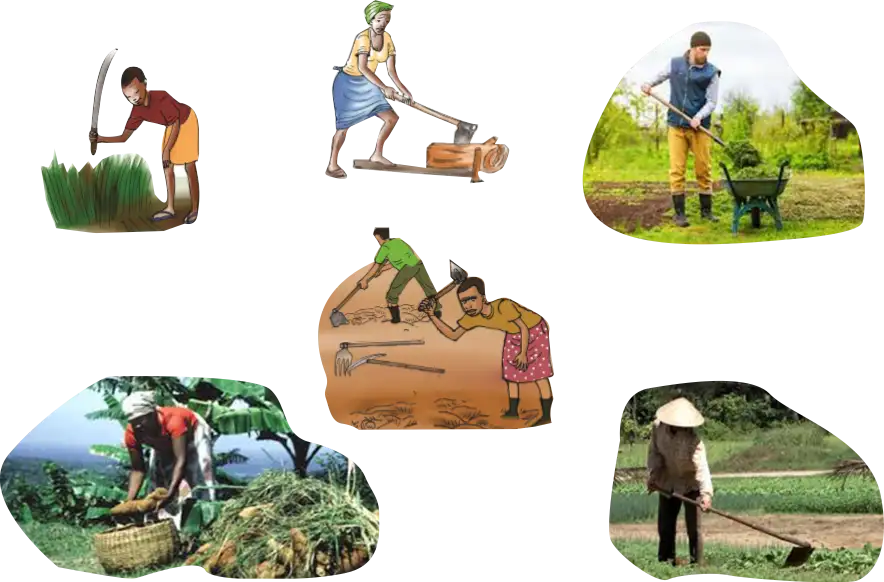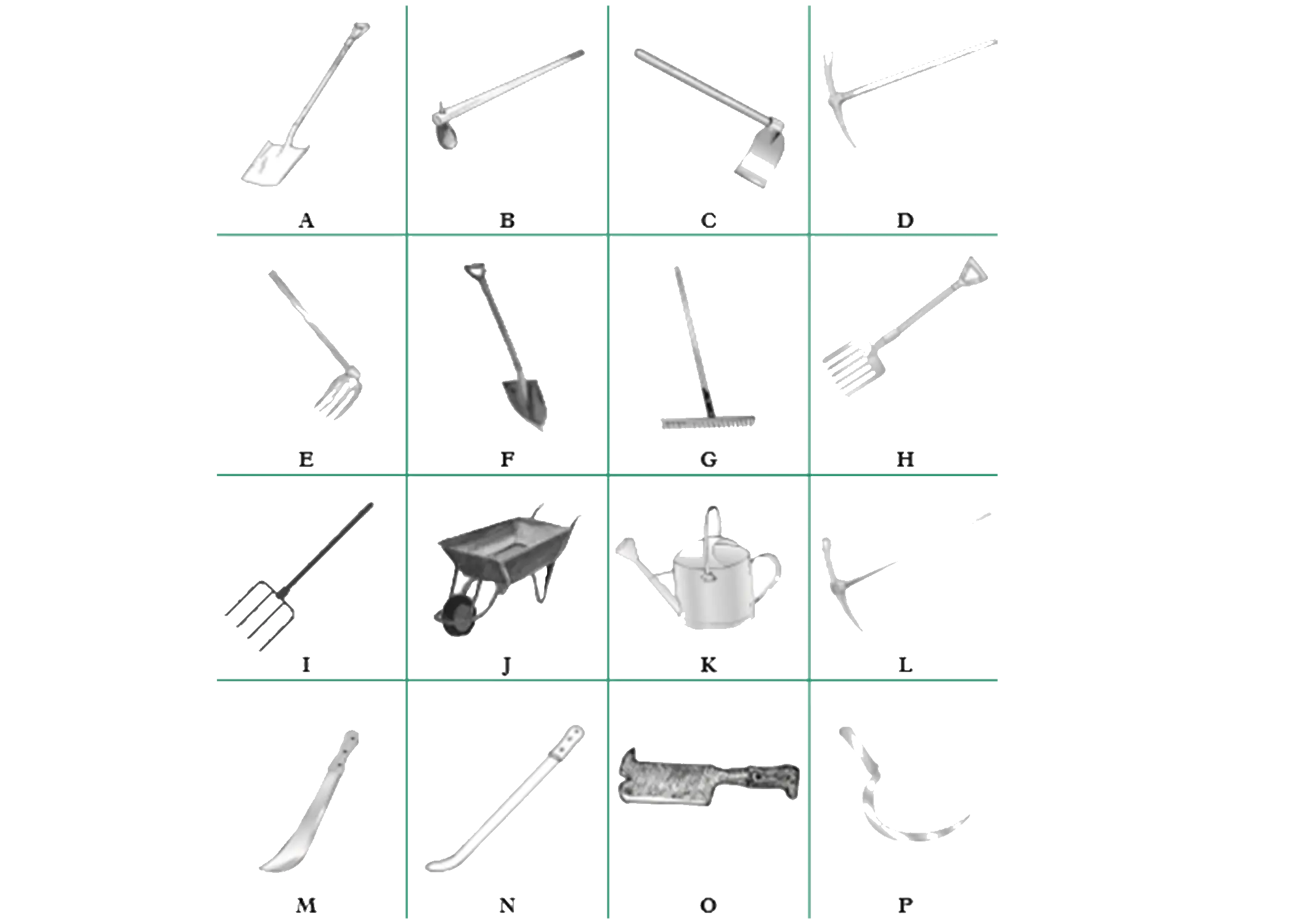Lesson Plan on Agriculture
Basic Farm Tools
Theme: Processes of agricultural production
Topic: Basic farm tools
Sub Topic: Basic farm tools
Date: dd/mm/yyyy
Class: Basic Two
Duration: 35 Minutes
No of Learners: 30
Learning Objectives:
By the end of the lesson learners should be able to:Say what basic farm tools are.
Basic are farm tools are simple materials used by farmers for performing various farming activities on the farm.
Identify and name some basic farm tools.

Machete-
It is mainly used for cutting down small trees and grass used to feed livestock. It is also used to clear the land before cultivation.Axe-
It is used for: Cutting tree stumps. Felling big trees during the initial stages of land preparation. Splitting trees into logs for the construction of farm structures and firewood.Pickaxe-
It is used for: Digging out stony grounds and hard soil. Uprooting tree stumps before ploughing. Cutting tree roots during land preparation.Digging hoe -
It is used for the cultivation of land when preparing the seedbed and during weeding. Digging foundations of farm structures and buildings. Preparing planting furrows and holes.Hand hoe -
It is used for the cultivation of land when preparing the seedbed and during weeding. Digging foundations of farm structures and buildings. Preparing planting furrows and holes.Wheelbarrow-
It is used for transporting small loads like sand, bags of seeds or seedlings (during transplanting), bags of fertiliser, among others within a short distance.Rake -
It is used for: Collecting uprooted plant roots and stems when preparing a nursery seedbed for vegetable crops. Breaking large soil clods, removing stones and other rubbish to obtain a fine tilth for tiny seeds. Levelling and finishing of the seedbed.Garden trowel -
This is a pointed scoop-like tool. It is used for: Loosening the soil. Digging small shallow holes. Lifting out seedlings from the nursery bed during transplanting.Garden fork-
It is used for: Weeding nursery or carrot fields. Preparing holes for transplanting seedlings.Watering can-
It is used for watering seedlings in seedboxes, potted plants, nursery beds and transplanted seedlings.Shovel-
It closely resembles the spade, but it has a tray-like blade. It is used for scooping loose soil, fertilisers, seeds and sand.Spade-
It is used for: Digging in place of a hoe, for instance in coffee plantations where the use of a hoe may damage coffee roots. Removing soil when digging holes and applying manure.Slasher-
It is used for clearing shrubs.Billhook-
It is used for cutting banana leaves.Forked hoe-
It is used for: Removing underground perennial weeds, such as couch grass. Digging hard, stony, wet or muddy soils. Harvesting tuber crops such as Irish potatoes.Garden shear-
It is used for trimming hedges and shrubs on the farm.Manure fork-
It is mainly used for moving heavy loads of manure or compost.Sickle-
It is a hand-held agricultural tool with a curved blade. It is typically used for harvesting grain crops or cutting succulent forage chiefly for feeding livestock.Bag-
It is used to store seeds, grains or seedlings.Head pan-
It is used for transporting small loads like sand, seeds or seedlings among others within a short distance.
Group basic farm tools.
- Cutting tools.
- Digging tools.
- Carrying tools.
Rationale:
In agriculture, there are so many tools and machines that can be used to facilitate various agricultural activities. Each of the agricultural tools and implements is usually used for specific operations. These tools can be used both during crop production and livestock production. All of them have an important role to play in the improvement of agricultural operations. Therefore, there is a need to teach our learners these basic agricultural farm tools.
Prerequisite/ Previous knowledge:
Learners have learnt about fruits and crops.Learning Materials:
Charts, pictures, farm tools, fruits, crops.Reference Materials:
Basic Agriculture for Primary Schools Pupils’ Book Two. By E.J. Usua, S.O. Olaitan, C.O. Uzuegbunam.Lesson Development:
| STAGE | TEACHER'S ACTIVITY | LEARNER'S ACTIVITY | LEARNING POINTS | ||||||||||||||||||||||||||||||||||||||||||
|---|---|---|---|---|---|---|---|---|---|---|---|---|---|---|---|---|---|---|---|---|---|---|---|---|---|---|---|---|---|---|---|---|---|---|---|---|---|---|---|---|---|---|---|---|---|
| INTRODUCTION full class session (3 mins) | Teacher asks learners. Name some fruits and crops you know. | Learners expected to respond. Apple, Orange, Okro, Yam,etc. |
Confirming the previous lesson. | ||||||||||||||||||||||||||||||||||||||||||
| DEVELOPMENT Step 1. Group Work (2 mins) | The teacher guides the learners to form four groups and ask them to choose their leaders and secretaries. | Learners choose their group leaders and secretaries. | Inculcating leadership skills, competitive spirit, cooperation, teamwork and a sense of responsibility among learners. | ||||||||||||||||||||||||||||||||||||||||||
| INTRODUCTION Step 2 Full class session (7 mins) | The teacher asks learners, all the fruits and crops mentioned in the learners' activity. Where do they come from? The teacher asks a follow-up question, who work on the farm to produce these fruits and crops? |
Learners respond. They come from the farm. Learners response, the farmer work on the farm. |
Developing the ideas of the concepts of the topic basic farm tools. | ||||||||||||||||||||||||||||||||||||||||||
| Teacher gives the class a prompt (the farmer does work on the farm with the use of simple farm tools/materials like the cutlass, hoe). The teacher asks learners to discuss in a group, what do you understand by the term, basic farm tools. |
Learners responses froms groups; Basic farm tools are the simple materials used by farmers to work on the farm. |
The teacher writes the topic on the board. | |||||||||||||||||||||||||||||||||||||||||||
| The teacher display pictures on the board and asks learners to identify the pictures. | Learners identify the pictures as basic farm tools. 
|
Basic farm tools. | |||||||||||||||||||||||||||||||||||||||||||
The teacher asks learners to explain what the farmers are doing in the pictures.
|
Learners response,
|
Developing the idea of a grouping of basic farm tools. | |||||||||||||||||||||||||||||||||||||||||||
| The teacher asks learners, the activities perform by the farmers in the pictures can be grouped into ____, ____ and _____ The teacher gives the class a prompt (two farmers are cutting with a cutlass and axe, three farmers are digging with a hoe, two farmers are carrying with a basket and wheelbarrow). |
Learners response,
|
Grouping of basic farm tools. | |||||||||||||||||||||||||||||||||||||||||||
| Stage 3 Group work activity (10 mins) |
The teacher gives learners activities. Group the tools in the chart according to their usage by the farmer for cutting, digging and carrying in a tabular form. The teacher should guide learners in the activity.
|
Learners carried out the activity in a group.
|
Identification and grouping basic farm tools. | ||||||||||||||||||||||||||||||||||||||||||
| Evaluation. Full class session (10 mins) | Ask the following questions to evaluate the achievement of the set objectives.
|
Learners expected response:
|
Confirming the achievement of the set objectives. | ||||||||||||||||||||||||||||||||||||||||||
| Conclusion, full class session (3 mins) | Ask learners, What are the use of cutting tools, digging tools and carrying tools? |
Learners expected response. Learners concluded the lesson that.
|
Acquiring/ improving understanding of the basic farm tools. | ||||||||||||||||||||||||||||||||||||||||||
| ASSIGNMENT | The teacher gives learners a take home. Draw, colour and label the basic farm tools below. 
|
Learners answer other questions. | Improving their level of understanding of the basic farm tools. | ||||||||||||||||||||||||||||||||||||||||||